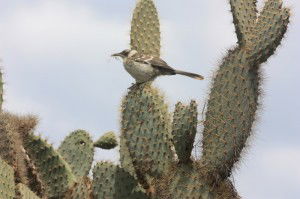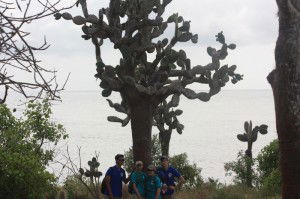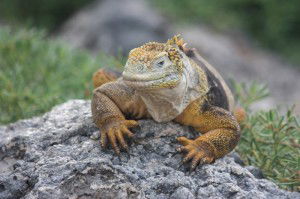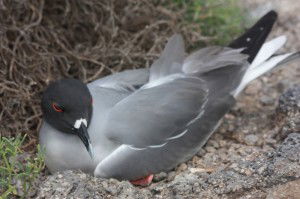Galapagos Adventure—Day 7
Yesterday we visited Santa Fe Island and the Plaza Islands. We saw many different birds on Santa Fe including the Galapagos dove, Galapagos mockingbird, and the cactus finch. There are many tree-like prickly pears on this island, so there are a great number of cactus finches. They eat and nest in the cactus. It is amazing to think of God designing a bird to be able to utilize the cactus in a post-Fall world for food and a home.
The land iguana was probably one of the most prominent features of both Santa Fe and the Plaza Islands. They look very different from their marine counterparts. Land iguanas are a combination of yellow and black (one species on Volcano Wolf is even pink) and much larger than the marine iguanas. They are larger because their food source is plentiful, nutritious, and they don’t have to expend as much energy to obtain it. They position themselves under the prickly pear cactus waiting for the pads to fall so they can eat them, spines and all! They also eat other vegetation which is still abundant at the end of the wet season. They don’t appear in groups as the marine iguanas do for warmth, as they have the opposite problem of getting too warm. They will often hide under vegetation to cool down.
I personally enjoyed seeing and photographing the swallowtail gull. They are beautiful duck-like birds that have soft-looking gray, black, and white feathers. Like the Galapagos dove they also have a colorful red eye ring. They are the only known gull that hunts at night. The red eye ring may aid with their night vision, and they may also use the bioluminescence of some sea creatures to see their prey. I could not believe how docile they were, and I had to be careful not to step on them because they don’t move when you come near.
The most exciting part of the day was when our naturalist had to fight off a male sea lion so we could land on the Plaza Islands. This was the largest male we had seen to this point and he was not happy with us landing near his females and babies. The bite of a male sea lion is viscous, so they have to be taken seriously. The naturalist had to run several times as the sea lion chased him on land. A couple of times the sea lion swam near the panga we were sitting in, and considering that he probably weighs over 500 pounds, I was concerned he might tip us over or try to board! Our naturalist was able to keep him away from us using his life jacket as we hurriedly got on shore. The sea lion even gave us problems when we tried to leave. Their eyesight is not good, so I don’t blame him for acting that way and seeing us as potential threats. During the day other male sea lions on the island try to fight the dominant male for territory. If they lose, they swim to the other side of the island and climb enormous cliffs (which look impossible to me!) and rest, waiting for the next day to try again.
Today we explore Santa Cruz and the Charles Darwin Research Station, where we will get our first glimpse of the giant tortoises. We will also walk through a lava tube. It is weird to be sitting in the bay and looking at an island with houses and people—ah, civilization! Hopefully this is where I will have internet access and be able to send blogs and photos and contact home. It’s hard to believe I’ve been gone a week and I’m looking forward to another interesting week and then going home. Enjoy the pix!

Answers in Genesis is an apologetics ministry, dedicated to helping Christians defend their faith and proclaim the good news of Jesus Christ.
- Customer Service 800.778.3390
- Available Monday–Friday | 9 AM–5 PM ET
- © 2026 Answers in Genesis








